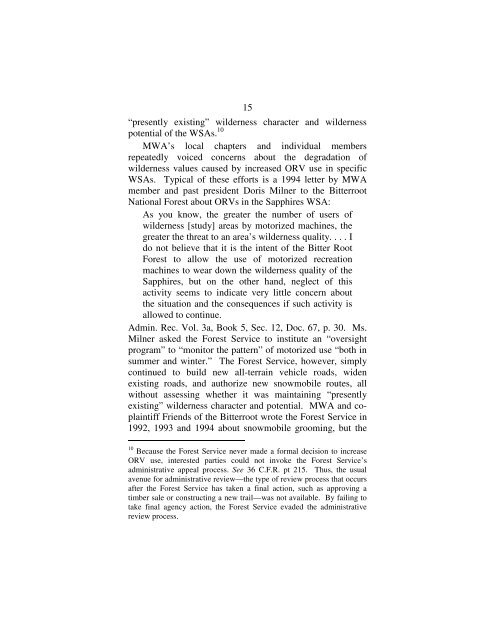Brief Amicus Curiae Of Montana Wilderness Association In Support ...
Brief Amicus Curiae Of Montana Wilderness Association In Support ...
Brief Amicus Curiae Of Montana Wilderness Association In Support ...
You also want an ePaper? Increase the reach of your titles
YUMPU automatically turns print PDFs into web optimized ePapers that Google loves.
15<br />
“presently existing” wilderness character and wilderness<br />
potential of the WSAs. 10<br />
MWA’s local chapters and individual members<br />
repeatedly voiced concerns about the degradation of<br />
wilderness values caused by increased ORV use in specific<br />
WSAs. Typical of these efforts is a 1994 letter by MWA<br />
member and past president Doris Milner to the Bitterroot<br />
National Forest about ORVs in the Sapphires WSA:<br />
As you know, the greater the number of users of<br />
wilderness [study] areas by motorized machines, the<br />
greater the threat to an area’s wilderness quality. . . . I<br />
do not believe that it is the intent of the Bitter Root<br />
Forest to allow the use of motorized recreation<br />
machines to wear down the wilderness quality of the<br />
Sapphires, but on the other hand, neglect of this<br />
activity seems to indicate very little concern about<br />
the situation and the consequences if such activity is<br />
allowed to continue.<br />
Admin. Rec. Vol. 3a, Book 5, Sec. 12, Doc. 67, p. 30. Ms.<br />
Milner asked the Forest Service to institute an “oversight<br />
program” to “monitor the pattern” of motorized use “both in<br />
summer and winter.” The Forest Service, however, simply<br />
continued to build new all-terrain vehicle roads, widen<br />
existing roads, and authorize new snowmobile routes, all<br />
without assessing whether it was maintaining “presently<br />
existing” wilderness character and potential. MWA and coplaintiff<br />
Friends of the Bitterroot wrote the Forest Service in<br />
1992, 1993 and 1994 about snowmobile grooming, but the<br />
10 Because the Forest Service never made a formal decision to increase<br />
ORV use, interested parties could not invoke the Forest Service’s<br />
administrative appeal process. See 36 C.F.R. pt 215. Thus, the usual<br />
avenue for administrative review—the type of review process that occurs<br />
after the Forest Service has taken a final action, such as approving a<br />
timber sale or constructing a new trail—was not available. By failing to<br />
take final agency action, the Forest Service evaded the administrative<br />
review process.
















